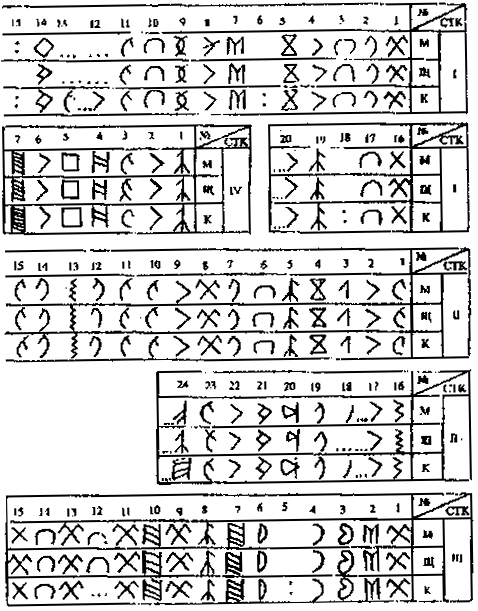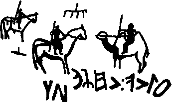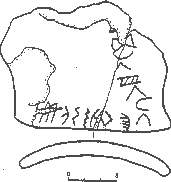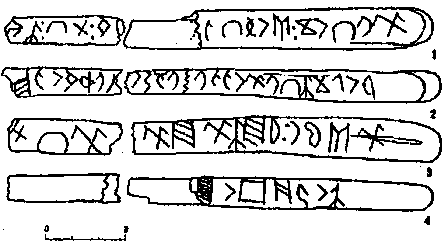Back
In Russian
Codex of Inscriptions - Index
Roots
Writing
Religion
Geography
Archeology
Coins
Turanian Writing
Paleography of 8 Türkic Alphabets
Codex of Inscriptions-Euro Asiatic - Kuban
Codex of Inscriptions-Euro Asiatic - S. Enisei
Codex of Inscriptions-Euro Asiatic - Isfar
Avar Dateline
Besenyo Dateline
Bulgar Dateline
Huns Dateline
Khazar Dateline
Kimak Dateline
Kipchak Dateline
Kyrgyz Dateline
Sabir Dateline
Türkic Scripts - Codex of Inscriptions
Euro Asiatic Subgroup
Achiktash (Talas) Script
Introductionn
I.L Kyzlasov in his book Writings Of Eurasian Steppes assembled a Codex of Inscriptions. The Euro Asiatic group, per I.L Kyzlasov, includes Don, Kuban, S. Enisei, Achiktash, and Isfar scripts. Achiktash (code A) is also called Talas (code T), and includes inscriptions from the r. Chu area.
I.L Kyzlasov attributs the Achiktash script to the population of the Jety-Su, (in Russian literature Jety-Su is called with a russified translation Semireshie = Seven Rivers) in the period of the 7-th - 8-th centuries. For craniological description of the Usun population in Jety-Su area click here.
Codex of Inscriptions - Achiktash
A 1. Achiktash (Talas) plank
Grafitti on four sides of two fragments of a wooden core. In line 1 remain 11 full and one fragmentary signs on the a large fragment (line length 7,7 sm) and 7 full and one fragmentary sign remain on a small fragment (line length 4 sm).
Letter height respectively from 1 to 0,5 sm (0,7 sm average) and from 0,8 to 0,5 sm. In line 2 are respectively 17 and 7 signs (line length 9 and 4 sm) height from 0,9 to 0,5 sm (0,7 sm average) on both parts. In line 3 are respectively 11 and 3 signs (line length 9 and 3,5 sm), height from 1,1 to 0,8 sm (average 0,9-1 sm) and 1,1, 0,8 and 0,6 sm. In line 4 occupying only a part of a long fragment, in the line of the length of 5,5 sm are 7 signs, height 0,9 sm (once - 1.0 and twice - 0,6 sm).
Date undetermined. (i.e. by publication of I.L Kyzlasov's book, no scientific dating was performed - Translator's Note)
Found in 1932 by I.F.Marinyanin in ancient mines while digging a geological exploratory well in the Achiktash deposit near a station Dmitrievskaya on r. Talas (Fig. 7,7).
Stored in State Hermitage, cat. ¹ SK-890.
| À1 | |
|
Sketch by the author
|
Sketch by
A. Amanjolov, p. 103 |
Òàáëèöà XXXIX
Perception of the Achiktash inscription's signs by S.E.Malov (Ì), A.M.Shcherbak
(Ù) and I.L.Kyzlasov (Ê)

Publications:
Malov S.E. Talas epigraphic monuments. - Materials of Uzkomstaris. M. - L., 1936, issue 6-7, Figs. 5-9;
Malov S.E. Monuments of the Ancient Turkic writing of Mongolia and Kirghizia. M. - L., 1959, Fig. 14-18;
Scherbak A.M. Signs on ceramics, Fig. 6;
Djumagulov Ch. Epigraphics of Kirghizia. Issue 1. Frunze, 1963, Fig. 7-8;
Kyzlasov I.L.Ancient Turkic runic writing of Eurasia, Fig. 37.
Altai Amanjolov A.S. Genesis Of Türkic Runic Alphabet, Almaty, "Mektep", 2003
Attempts of reading:
Malov S.E. Talas epigraphic monuments, pp. 28-38
Malov S.E. Monuments of the Ancient Turkic writing of Mongolia and Kirghizia, with. 63-68
Orkun H.N. HN Eski Turk Yazitlari. Istanbul, 1940, ñ. 209-214 (ôàêñèìèëå: Ankara, 1987, ñ. 619-624);
Scherbak A.M. Signs on ceramics, pp. 387, 388;
Turchaninov G.F.Monument of the scripts, pp. 90-96.
Altai Amanjolov A.S. Genesis Of Türkic Runic Alphabet, Almaty, "Mektep", 2003
Transliterations of the text:
Batmanov I.A.Talass monuments of the Ancient Turkic writing. Frunze, 1971, pp. 17, 18, 27-30.
Djumagulov C. Epigraphics of Kirghizia. Issue 1, pp. 22, 23;
Malov S.E. Monuments of the Ancient Turkic writing of Mongolia and Kirghizia, with. 63-68
Altai Amanjolov A.S. Genesis Of Türkic Runic Alphabet, Almaty, "Mektep", 2003
Transcription
Not available
| Transliteration | |
| (per S.E.Malov) | |
|
1. ağıpaşu altım
əbəşiq...
amidişaçu... |
1. aγïpan
oz. altu äb
anï...m d'nç... |
| Translation | |
| (per S.E.Malov) | (per A.S.Amanjolov) |
| 1. Having risen, I passed over the top of the mountain. My childhood pals... Opening the vessels now... | 1. Having risen, get rid (of hell's tortures)! Be prepared for "six habitats" (six forms of existence)!... |
|
2. On the brim (located on the bend, at the edge) knoll (or a stone bullwark, sacrificial
pile of rocks). Helping each other on a new path over the top of the mountain and reaching the top, thus going over... |
2. ...Open up (repent) and recount (required) about illnesses! Thus, everyone be consoled!... |
|
3. I came; here's the plain. Passing over an internal gorge (a mouth
of the mountain), the ascention we(ll)... |
3. Make to rise (to think heavenly) and be consoled! Recount
the element of mind qaçïγ (in the teaching of Buddhism) and
prepare
Kagan! |
| 4. Initiating (the road) and crossing the top, a little... | 4. Gift spoon (possibly, for sacrificial aspersion). |
In the text are readable only 14 words. of them, 12 start with "a" (the other two words, as thinks Malov, are distorted), the rhyme of the first syllables looks like this:
ağ (6 times) aç (2 times), al, əb, am, aş.
The plank was found in Achiktash deposit, sticking out from the wall of the well ¹ 7, which was a partially opened ancient mine, at a depth of 5 m, and a part of the artifact was not recovered. M.E.Massoy studied the conditions of the find and transferred the materials to S.E.Malov, and the plank to the State Hermitage in the1933. In 1936 both researchers published this written monument, presenting a photo and sketches of all of its sides. S.E.Malov offered a reading of the inscription and its paleographic analysis. In 1940 another translation was offered by H.N.Orkun, who again published M.E.Masson's and S.E.Malov's illustrations and sketches. In 1953 S.E.Malov included his work about the Achiktash find in a monography about runic inscriptions of Mongolia and Kirghizia, adding a drawing of the plank from four sides to the sketches of the inscription. In the same year not quite an exact copy of the S.E.Malov's sketches was republished by E.R.Rygdylon.
In 1959 A.M.Scherbak undertook a principally new attempt of transliteration and reading of the text, publishing his version of the graphics of the signs ( tab. XXXIX) and a new photo of the plank. In 1963 C.Djumagulov published a new sketch of the inscription and its transliteration, with a copy of the drawing, transcription and S.E.Malov's translation. These materials were republished by I.A.Batmanov with slightly changed transliteration by the predecessor.
The majority of the researchers, noting the difference of the form of the written signs in the Talas plank, offered them the Orkhon-Yenisean phonetic interpretation. Only S.E.Malov "for a long time hesitated to recognize the inscription on the plank for Türkic runes" and, even offering his reading of the text, noted that his doubts are only partly swayed. He repeatedly said: "At the first sight at the letters of this plank is visible their difference in comparison with the letters of the Orhon, Yenisei and Eastern Turkestan runic writings... Some letters have no analogies in other Türkic runic monuments... Here are new letters with unknown value". Simultaneously with that, S.E.Malov at once pointed that "from the outlook, the letters of the plank are very similar to the Besenyan letters and Hungarian carvings", meaning the Nadsentmiklosh and Sekel inscriptions. The Nadsentmiklosh runes underlay the S.E.Malov's sound interpretation of two signs, the Hungarian runes of the sign as stepladder. A.M. Scherbak considerably developed this research direction, having noting the big similarity of signs on the plank with runes of the N.Pontic steppes. In 1971 he wrote justifiably: "Despite of the carefulness of the writing and good state of preservation of the most of the inscription, its reading by the means of the Orkhon-Yenisean Türkic alphabet, in essence, appeared impossible". In 1983 the similarity of the engravings on the plank and inscriptions of the Eastern Europe was also noted by D.D.Vasiliev. A paleographic description of the inscription was made by us in 1990 and accompanied with a new sketch of the monument.
Comments by A.S.Amanzholov
In the degree of scientific reliability experience of S.E.Malov for a long time remained unsurpassed, and the subsequent researchers did succeed to avoid the discrepancies of the first publication, and to justify a "batter" translation. Rejecting the amateurish attempts "to correct" S.E.Malov and other Türkologists, I offered a new reading of the 4th line of the inscription, and by being able to read it, I expressed confidence that this unordinary inscription belongs to the Türkic runes.
I offer the suggested reading of the runic inscription on the Talas plank, and the best analysis achieved for today (March, 14, 2002).
Judging by the suggested reading (by A.Amanzholov), the ancient Türkic runic inscription on a wooden plank is about sacred concepts, most likely, of the Buddhist teaching, because the Buddhist teachers and the philosophy of Buddhism in the 6th - 8th centuries had special privileges among the Turkic Kagans.
The inscription contains, alongside with known letters, unusual for Turkic
runic letter
![]() n (the letter was used 6 times, it is also noted on a Sassanian silver dish
from Western Kazakhstan, near r. Ural),
n (the letter was used 6 times, it is also noted on a Sassanian silver dish
from Western Kazakhstan, near r. Ural),
![]() b (the letter was used 1 time, compare with usual runic graphics
b (the letter was used 1 time, compare with usual runic graphics
![]() b) and earlier unknown, an archaic letter "ladder"
b) and earlier unknown, an archaic letter "ladder"
![]() q, which in other Talas monuments has a simplified graphics
q, which in other Talas monuments has a simplified graphics
![]() q (compare Phoenician
q (compare Phoenician
![]() kh).
kh).
Lexicon of an inscription: au - "to rise (upwards), to ascend", oz -"to save, to free, to rid", altu (altı) "six", eb "dwelling, stan", anï - "to prepare, to groom", açïn - "to reveal; to state frankly, repent", aj γu (a participle of absolute future time with modal meaning of obligation from the verb aj - "to say, to tell; to name "), ig "illness", apïn-~ abïn- "to be consoled, enjoy", ançïp-ïnçup (ïnçïp) "so, thus; then", qamu (qamuγ) "all; all without exception; anyone", aγïlt - "force up, force to become airborne" (aγ-ïl-t-), qaçïγ "(in the Buddhist treatises in ancient Türkic language) one of the organs of subjective perception, forming support for consciousness", qaγan "Kagan, Supreme Ruler, Supreme Khan", anïd- (anït-) "force to get ready; prepare, to assign, save" (form of imperative case), açuγ (açïγ ) "reward, compensation; gifts", qasuq "spoon" (the head of the spoon, probably, had remained in the wall of the exploratory trench at a depth of 5 meters).
Apparently, the inscription on a wooden plank (handle of a spoon) is a testimony to the ancient roots of the Türkic script and of the Buddhism in the Middle Asia.
A 2. Tozbulak
Chiseled on a rock with pictures. Two horizontal lines; the second, probably, is a result of the displacement of the first. In the first are 9, in the second are 2 signs. The sizes are unknown.
Date undetermined.
Found in 1976 by A.V.Oskin in a gorge of the Tozbulak well on the southern slope of the Kuldzhuktau mountains (desert Kyzyl Kum, about 100 km north of Bukhara) (Fig. 7,2).
Located in the place of find.
A 2. By A.V.Oskina's sketch

Publications:
Oskin A.V. New finds of petrogliphs in Kyzylkums. - Field research of Institute of ethnography. 1976. Ì., 1978, Fig. 5.
Attempts of reading:
Klyashtorny S.G. Rock runic inscription in Kyzylkums. - Field research of Institute of ethnography. 1976. Ì., 1978, p. 173.
Transcription
Not available
Transliteration
Not available
Translation
Not available
Inscription chiseled by dot technique. In 1978, A.V.Oskin published a brief description, a scaleless photo of the artifact sketch and graphic copy of this monument, made by tracing the photo. Simultaneously, S.G.Klyashtorny attempted to read the inscription based on the Orkhon-Yenisean writing that caused a number of complications and assumptions. A paleographic description of the text and reprinting of the sketch was made in 1990.
A 3. Altyn-Asar
Graffiti on a fragment of a vessel. Two lines at a right angle. In the first line are 7 full signs and a part of the eighth. Overall length 6,5 sm, height of letters from 1,1 (once - 0,8 sm) to 1,6 sm. In the second line also are 7 full and partially preserved eighth sign. The length of the line 6 sm, height of letters from 1,4 to 1,1 sm (the last most frequent).
Date - end of the 7th - beginning of the 8th century ?
Found in 1987 in the rubble fill of a room of the 1st building of the 4th Altyn-Asar fortresses in the delta of the r. Syr-Darya (Fig. 7,9). Excavations by L.M.Levina.
Stored in the funds of the Khorezmian expedition of the Institute of Ethnology and Anthropology of the Russian Academy of Science.
A 3. Sketch by the author

Publications:
S.G.Klyashtorny, Levina L.M. About one runic inscription from Altyn-Asar fortresses (Eastern Aral). - Ethnic history and traditional culture of peoples of Central Asia and Kazakhstan. Nukus, 1989.
Attempts of reading:
Never published.
Transcription
Not available
Transliteration
Not available
Translation
Not available
The dating of the ancient building from where came a fragment of the neck of a jug with an inscription is the end of the 6th - 8th century; the fragment was found above the floor of the building. L.M.Levina and S.G.Klyashtorny published a photo and a sketch of the inscription, paleographic description of the text as an analogue to the runic inscriptions of the "from Volga region to Danube" territory, illustrated with a comparative table. Was mentioned the spread of this script in the Central Asia and Siberia, which aligns with its Pra-Bulgarian ancestry. Similar comparisons are based on single examples, which cannot create a reliable bases for the paleographic, or for historical conclusions.
